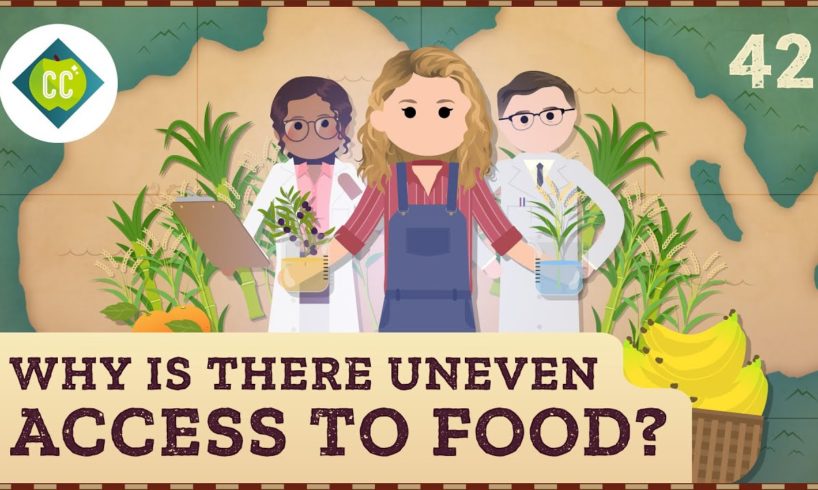
Food insecurity, or the lack of access to enough nutritious food, is a complex problem. In the 21st century, even with all of our advances in technology, access to food is still uneven. Today we’re going to look at the diffusion of food across the globe during the Columbian Exchange and examine how changes in food technology from the Agricultural Revolution to the Green Revolution to the Genetic Revolution have played a significant part in food availability across the globe.
SOURCES
General
For a free and open source option for Intro to Human Geography, see: https://humangeography.pressbooks.com/
For a free and open source option for World Regional Geography, see: https://worldgeography.pressbooks.com/front-matter/introduction/
Cracking the AP Human Geography Exam: 2020 edition. The Princeton Review.
Hobbs, Joseph J. Fundamental of World Regional Geography, 4th ed. Cengage. 2017.
Miller and Spoolman. Living in the Environment 19th ed. Belmont, CA: Brooks/Cole,
Cengage Learning. 2017. ISBN: 978-1-337-09415-3
Gregory, Derek, Ron Johnston, Geraldine Pratt, Michael Watts, and Sarah Whatmore, eds. 2009. The Dictionary of Human Geography. 5th ed. Willey-Blackwell. ISBN: 978-1-4051-3288-6
Chad
https://www.fao.org/hunger/en/
Wheat
https://www.fao.org/3/Y4343E/y4343e02.htm
https://muse.jhu.edu/article/488280
https://dergipark.org.tr/en/pub/jecs/issue/46756/586181
https://online.ucpress.edu/gastronomica/article-abstract/18/2/33/45845/You-Can-Never-
https://www.sciencedirect.com/science/article/pii/S0167880908000194 (wheat beat the heat)
ttps://www.nature.com/articles/s41598-021-95014-6
Overall production
https://ourworldindata.org/crop-yields
https://www.fao.org/3/u8480e/U8480E07.htm#Proportions%20of%20food%20in%20average%20diets https://scholar.harvard.edu/files/nunn/files/nunn_qian_jep_2010.pdf
https://theconversation.com/ocean-warming-has-fisheries-on-the-move-helping-some-but-hurting-more-116248
https://ourworldindata.org/crop-yields
https://www.fao.org/3/ac911e/ac911e05.htm
https://www.fao.org/3/Y4343E/y4343e02.htm
https://www.fao.org/faostat/en/#data/QCL/visualize
https://www.fao.org/worldfoodsituation/csdb/en/
Cost of Food/ Food Access
https://ourworldindata.org/grapher/share-of-consumer-expenditure-spent-on-food-vs-gdp-per-capita
https://www.fao.org/3/ca9731en/ca9731en.pdf
https://www.fao.org/hunger/en/
Food Origins
https://www.npr.org/sections/thesalt/2016/06/13/481586649/a-map-of-where-your-food-originated-may-surprise-you
https://scholar.harvard.edu/files/nunn/files/nunn_qian_jep_2010.pdf
Watch our videos and review your learning with the Crash Course App!
Download here for Apple Devices: https://apple.co/3d4eyZo
Download here for Android Devices: https://bit.ly/2SrDulJ
Crash Course is on Patreon! You can support us directly by signing up at http://www.patreon.com/crashcourse
Thanks to the following patrons for their generous monthly contributions that help keep Crash Course free for everyone forever:
Dave Freeman, Hasan Jamal, DL Singfield, Lisa Owen, Jeremy Mysliwiec, Shannon McCone, Amelia Ryczek, Ken Davidian, Stephen Akuffo, Toni Miles, Erin Switzer, Steve Segreto, Michael M. Varughese, Kyle & Katherine Callahan, Laurel Stevens, Vincent, Michael Wang, Stacey Gillespie (Stacey J), Jaime Willis, Alexis B, Burt Humburg, Aziz Y, DAVID MORTON HUDSON, Perry Joyce, Scott Harrison, Mark & Susan Billian, Junrong Eric Zhu, Rachel Creager, Matt Curls, Tim Kwist, Jonathan Zbikowski, Jennifer Killen, Sarah & Nathan Catchings, Brandon Westmoreland, team dorsey, Trevin Beattie, Divonne Holmes à Court, Eric Koslow, Jennifer Dineen, Indika Siriwardena, Khaled El Shalakany, Jason Rostoker, Shawn Arnold, Siobhán, Ken Penttinen, Nathan Taylor, Les Aker, William McGraw, ThatAmericanClare, Rizwan Kassim, Sam Ferguson, Alex Hackman, Jirat, Katie Dean, Avi Yashchin, NileMatotle, Wai Jack Sin, Ian Dundore, Justin, Mark, Caleb Weeks
__
Want to find Crash Course elsewhere on the internet?
Facebook – http://www.facebook.com/YouTubeCrashCourse
Twitter – http://www.twitter.com/TheCrashCourse
Tumblr – http://thecrashcourse.tumblr.com
Support Crash Course on Patreon: http://patreon.com/crashcourse
CC Kids: http://www.youtube.com/crashcoursekids
#Geography #CrashCourse #Food
source







This is a re-upload. So sorry for the confusion everybody! We had made a pretty big map blunder (misidentifying Puerto Rico) that really needed to be patched. Thanks so much for your feedback! – brandon
Don't forget that starving peasants make poor revolutionaries. Maintaining low nutritional support can easily be a tool to protect local rulers.
To your point about food diversity: I'm a medieval historian, and one of the most interesting things when looking at the historical foods of Europe (early modern and earlier) vs. today is the sheer variety of foods they would eat (especially the upper classes), that we don't eat at all nowadays. Tons of different types of game meat, birds, fish and seafood, etc. that would be impossible to find in grocery stores, and hard to find even in luxury grocery stores. Today, we're used to seeing beef, chicken, and pork in the meat aisle, maybe with a few extra "luxury meats" for fancy meals, but at a medieval feast, you might have dozens of different types of animals being eaten. Medieval people ate a far more diverse diet than us modern folk, for sure!
very informative!
feeding a hungry child costs pennies. dislodging an entrenched insurgency costs trillions of dollars if it can even be done at all.
Thanos is ight. There is too much life. Looking for nutrition in Pringles is ridiculous.
Well done, and a touchy subject handled intelligently and fairly. This is a topic that gets REALLY personal for so many (myself included), and it's incredibly difficult at times to separate fact from feelings. Thank you for your hard work on this script in particular!
Thank you!
How did you make this entire episode without saying the word "capitalism"? I mean, you pretty much laid out the problem: there is enough food for everyone . . . it just isn't profitable for the people at the top to help the people at the bottom have enough to eat.
facinating
capitalism, currently that is the only reason
Companies throw out what they cannot profit off of.
The value of profit is greater than the value of humane support.
capitalism.
Wow
9:30 Food deserts can also be financial. There's a grocery store across the street from me, but it's a "luxury/premium" grocery store, so almost everything in it is drastically overpriced. I have to drive halfway across town to get to the nearest normal/"cheap" grocery-store (assuming the car is working). 😕
Truly fantastic episode. Thank you.
I don't know. America has the highest number of obese people that are below the poverty line. In Africa, there's plenty of food aid, but due to infrastructure issues and military conflicts, it can be hard to consistently get food to those populations safely, and in a timely manner. I think it has more to do with non industrialized nations wading the growing pains of becoming industrialized. Hey, China figured it out.
uploading the SAME Video within 2 or 3 days is Poor Taste. This same video showed up in my Notifications YESTERDAY. Please stop wasting our time.
This video could be really short. The answer is capitalism.
Great host!
Strangely this is at the exact intersection between my full time job and one of my part time jobs
I’m always pausing the video in the beginning to read all the interesting facts in your intro. I really appreciate the detail and high level of quality y‘all put in your videos!!!
Deja Vu!
I've read "why is there even access to food?" like someone got angry that people actually have access to it 😅
Appreciate the video. Next time I highly suggest starting with a simple superficial answer to the question in your title and delving deep into it step by step.
I kept wondering why you are talking about the things you're talking about when I was actually really curious about the question.
It’s always white peoples fault 🙄🖕
If we were to stop industrial animal agriculture, we’d be able to feed everyone on the planet very easily.
Best video in the series so far! Nice that you guys took the time to reupload with the map correction.
35…….
Unequal access to food because corporate greed and govts have turned poverty and homelessness into a business. Even the UN has a law to which they can use the necessities of life against people. It's sad really.
Short answer: capitalism can't profit off of equal access to food as much as they can profit off of throwing food away to maintain artificial scarcity.
I'm from ethiopia and food prices are skyrocketing and it is so bad for all of us as the war enters it's 2nd year
Thank you
Thank you
Sad that no time was spent talking about Food Waste especially in the United States. Food is not accessible to poor people, who are often ethnic minorities, by design and food is thrown away rather than given out for free to whoever needs it. This series, informative as it is, consistently washes over the ways in which modern systems of capital create poverty and human suffering.
Capitalism